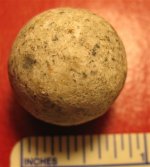THis conversation really took a left turn, but I would like to add my penny and a half to it. I have been in an antique store where the guy says he has ceramic case shot. They were the same size (most were "case shot" size, some were cannister size) as the "Olympic" marbles I purchased. For those not familiar with the story: A guy from Tennesse was digging for construction for the olympics in Atlanta, and according to his story, found a cistern with thousands of ceramic marbles that may have predated CW. You have maybe seen them, usually bright colors, and a guy on ebay always offers them with camp junk he finds. I ended up buying 3000 of these from the man, and sold and wholesaled them. Some had stars on them (more on that later, if anyone is interested). I broke a couple of them open, and a "knowledgeable" person said they were defiantely porcelin, as compared to clay in the blue and brown "benningtons". The difference in weight is remarkable. My suspicions are that the guy found all these marbles, colored them, and made a little money. But I suppose the real question is, why were they there? Were they actually marbles, or were they in a holding cistern at or near an ordinance factory? And if they were never used in ordinance, then is the original story of a pre war Atlanta marble factory real? Could lead have been in that short of supply, as well as iron or even nails that porcelin may have been used? Too much thinking, my head hurts. More thoughts on this are appreciated, and photos can be available if wanted. Cheers!



